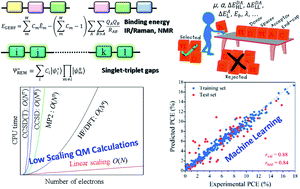Computational and data driven molecular material design assisted by low scaling quantum mechanics calculations and machine learning†
Abstract
Electronic structure methods based on quantum mechanics (QM) are widely employed in the computational predictions of the molecular properties and optoelectronic properties of molecular materials. The computational costs of these QM methods, ranging from density functional theory (DFT) or time-dependent DFT (TDDFT) to wave-function theory (WFT), usually increase sharply with the system size, causing the curse of dimensionality and hindering the QM calculations for large sized systems such as long polymer oligomers and complex molecular aggregates. In such cases, in recent years low scaling QM methods and machine learning (ML) techniques have been adopted to reduce the computational costs and thus assist computational and data driven molecular material design. In this review, we illustrated low scaling ground-state and excited-state QM approaches and their applications to long oligomers, self-assembled supramolecular complexes, stimuli-responsive materials, mechanically interlocked molecules, and excited state processes in molecular aggregates. Variable electrostatic parameters were also introduced in the modified force fields with the polarization model. On the basis of QM computational or experimental datasets, several ML algorithms, including explainable models, deep learning, and on-line learning methods, have been employed to predict the molecular energies, forces, electronic structure properties, and optical or electrical properties of materials. It can be conceived that low scaling algorithms with periodic boundary conditions are expected to be further applicable to functional materials, perhaps in combination with machine learning to fast predict the lattice energy, crystal structures, and spectroscopic properties of periodic functional materials.



 Please wait while we load your content...
Please wait while we load your content...